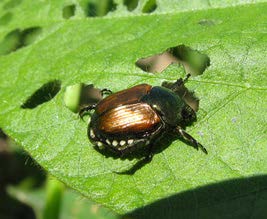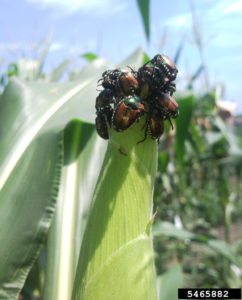
Figure 1. Japanese beetles feeding on soybean leaf
Identification and Life Cycle Figure
The damage from Japanese beetle feeding on corn and soybean can be eye-catching, especially on field edges. Japanese beetles have a large host range and can feed on corn silks potentially reducing pollination and kernel set and cause defoliation in soybean. Mild winters and early planting generally contribute to higher Japanese beetle populations. Adult Japanese beetles (Popillia japonica) are about 5/16 inch long, have a metallic green head and neck region, reddish to bronze wing covers, a row of six white bristle bunches along each side of the ir abdomen, and live about 30 to 60 days (Figure1).1 The adults emerge from the soil starting in late May and early June with peak emergence occurring four to five weeks later. Mating, which occurs soon after emergence, causes the females to burrow two to four inches into the soil to lay four to six eggs every three to four days for several weeks. Eggs take roughly two weeks to hatch into small grubs (larva). The grubs are 0.5 – 1.2 inches in length depending on the instar, typical white, and C-shaped and similar in appearance to other commonly found white grubs. Larvae are easily identified by a V-shaped arrangement of hairs (raster) adjacent to the anus. Japanese beetle grubs may heavily infest an area, however, a heavy white grub infestation is not always an indicator of potential severe injury from adult beetles, as the beetles are very mobile and can move large distances to locate a preferred food source.
The adults feed on pollen, tassels, silks, and leaves. Corn leaves may appear skeletonized or “lacy,” but leaf feeding is rarely of economic importance. Economic damage can occur when beetles prevent pollination by early silk clipping.
It is important to protect silks during the first five silking days. Silk clipping after pollination does not affect yield potential. When silks are clipped during pollination, this can interfere with pollination and the ears may be only partially pollinated (Figure 2). A representative portion of the field should be evaluated when scouting corn for Japanese beetles as populations could be overestimated if sampling is only conducted near field edges where Japanese beetles can congregate. An insecticidal treatment should be considered during corn silking stage if:
- There are 3 or more Japanese beetle adults per ear, and
- Silks have been clipped to less than a 1/2-inch, and
- Pollination is less than 50% complete, and • Japanese beetles are still present and actively feeding.(2)

Figure 2. Japanese Beetles feeding on corn silks. Photo courtesy of Daren Mueller, Iowa State University, bugwood.org.
Soybean Scouting and Thresholds
Although Japanese beetle feeding can cause major defoliation, soybean plants can compensate for the damage and defoliation is unlikely to affect yield potential. Flowering fields should be scouted for Japanese beetles and the extent of defoliation. The percent defoliation should be estimated on randomly selected leaves in at least five different areas of the field. An insecticide application should be considered if:
- 30% defoliation occurs prior to bloom or
- 20% defoliation occurs after bloom, and
- Japanese beetles are present and actively feeding.(2)
Management
Foliar applied insecticide control
Damage from Japanese beetles can add to other stresses the crop is experiencing, and economic thresholds may need to be adjusted if plants are under moisture stress.1 This, along with commodity prices, should be taken into consideration when using thresholds to determine if insecticide treatment is needed. Many products are labeled for foliar applied adult Japanese beetle control in corn and soybeans. Baythroid® XL insecticide and Leverage® 360 insecticide are two Bayer products labeled for this application. Insecticide recommendation for foliar applied adult control is an option when the population exceeds the control level for the crop. The type of insecticide approved and the rate of application for the insecticide can be different for corn or soybeans.
Foliar applied insecticides may initially control or knock-down a population; however, poor residual activity and the mobility of the insect could lead to the need for a second application if populations resurge later. With subsequent treatments, consider an insecticide with multiple or different modes of action (MOA).
In fields with a high risk for infestation, soil applied insecticides can also be used to target larvae (white grub) and adults that overwinter in the soil. These chemicals include imidacloprid and halofenozide, which have been effective against early-stage larvae. Other effective active ingredients include neonicotinoids, neonic plus abamectin, pyrethroids, organophosphates, pyrethroids plus organophosphates, and diamide seed treatments.3 White grubs feed on seed kernels and destroy germinating seeds.
Cultural control methods include irrigation during peak flight periods and adding more organic matter to the soil. This can help with controlling beetle populations by making it more difficult for the adult beetle to deposit eggs in the field. Biological controls include nematodes, parasitoid wasps, and bacteria have been identified as chemical control alternatives but are currently very expensive.(3)
Article Link – Control of Japanese Beetle in Corn and Soybeans
